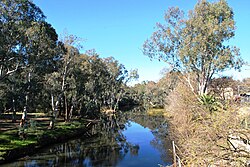| Ovens | |
|---|---|
 Ovens River at Wangaratta | |
 Course of the Ovens River in Victoria | |
| Etymology | In honour of Major Ovens, the Secretary to Governor Thomas Brisbane [1] |
| Native name |
|
| Location | |
| Country | Australia |
| State | Victoria |
| Region | Australian Alps (IBRA), Victorian Alps, Hume |
| Local government areas | Alpine Shire, Wangaratta City, Moira Shire |
| Towns and cities | Harrietville, Bright, Porepunkah, Myrtleford, Wangaratta |
| Physical characteristics | |
| Source | Great Dividing Range |
| Source confluence | East and West Branches of the Ovens River |
| • location | Harrietville |
| • coordinates | 36°53′15″S147°3′45″E / 36.88750°S 147.06250°E |
| • elevation | 529 m (1,736 ft) |
| Mouth | confluence with the Murray River |
• location | near Bundalong |
• coordinates | 36°2′15″S146°10′38″E / 36.03750°S 146.17722°E |
• elevation | 125 m (410 ft) |
| Length | 191 km (119 mi) |
| Basin size | 7,778 km2 (3,003 sq mi) |
| Discharge | |
| • average | 46 m3/s (1,600 cu ft/s) |
| Basin features | |
| River system | North-East Murray catchment, Murray-Darling basin |
| Tributaries | |
| • left | Morses Creek, Buckland River (Victoria), Buffalo River (Victoria), King River (Victoria) |
| National parks | Alpine NP, Mount Buffalo NP |
| [4] | |
The Ovens River, a perennial river of the north-east Murray catchment, part of the Murray-Darling basin, is located in the Alpine and Hume regions of the Australian state of Victoria.





